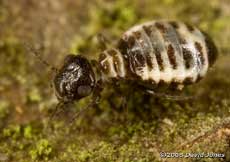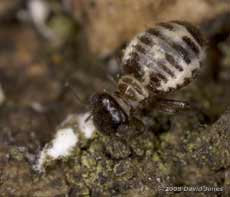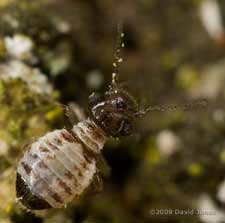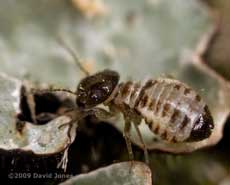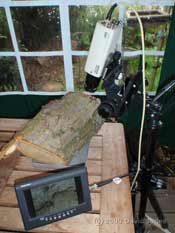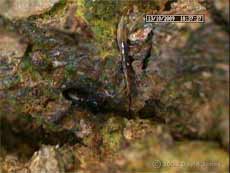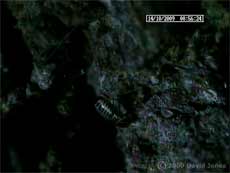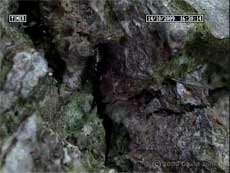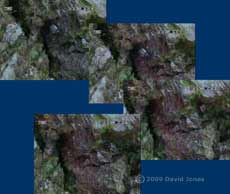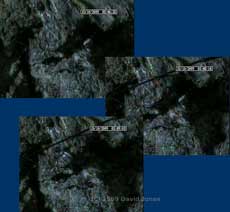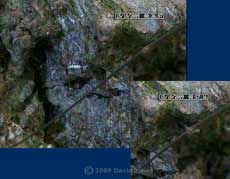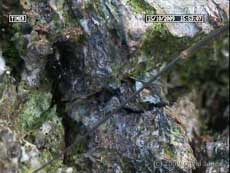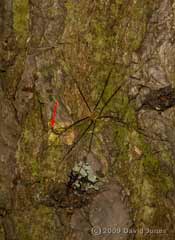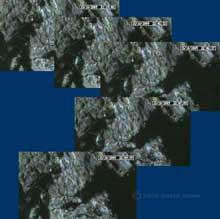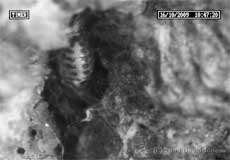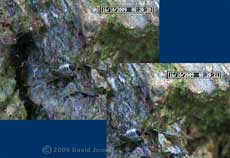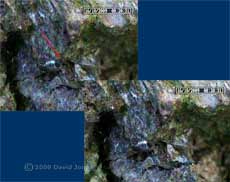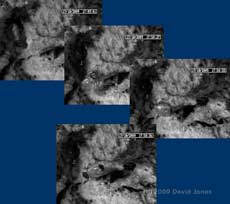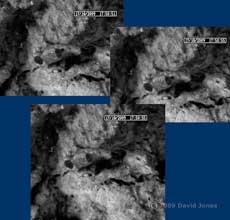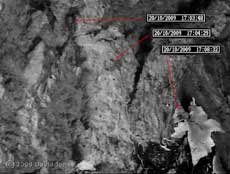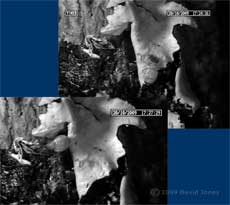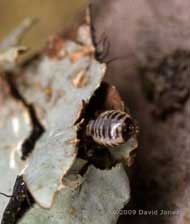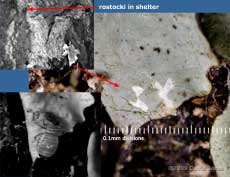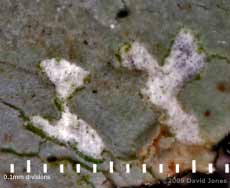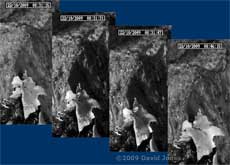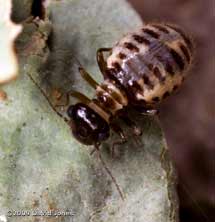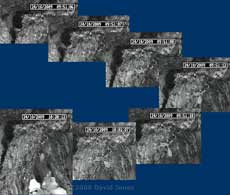|
An introduction Having a son who runs a tree surgery business seemed too good an opportunity to waste, and a couple of years ago we installed a log burner. As well as the burner a log store was needed, and dealing with the logs for that in effect introduced me to the barkflies, a group of insects that I had largely ignored until then. Since then I have found some fourteen species here, either on the logs or on trees and shrubs in the garden. While the garden plants have been a source of the more common species, such as Valenzuela flavidus, the logs have been a much more interesting source, with both common and uncommon species appearing. And it is not just fresh timber that is worth checking. I find that seasoned logs often have thriving 'colonies' of Peripsocus milleri, for example. With that in mind I try to ensure that as timber is used up, some 'old' logs that are inhabited are replaced in amongst younger timber in an effort to maintain the barkfly presence. Just occasionally a new supply of logs delivers a surprise, as happened at the beginning of November 2008.
It had me puzzled and I wasn't able to match it with any of the illustrations on the NBRS website, and my Barkfly handbook (T R New) didn't help. Fortunately, the next morning I had an e-mail from Bob Saville, identifying it as Pseudopsocus rostocki. Unfortunately, as the batch of timber came from more than one oak tree, my son wasn't able to pinpoint the exact location of where the log originated, apart from it being within 5 miles of his home in Farnborough, Hampshire.
I was able to photograph rostocki feeding on lichen. Thanks to Bob's contacts that has been identified as Melanelixia subaurifera (syn. Parmelia subaurifera, Melanelia suburifera). It appears to be concentrating on the upper cortex and algal layer of the lichen's thallus. After a few days I returned the log to a 'safe' part of the log store and when I rechecked the log it had disappeared.
September 2009
On 16 September My son let me know that during the previous few days he had felled two oak trees in a dangerous condition in a garden in Mytchett (SU889550) near Aldershot, and had brought the timber back to his property. On the 17th I collected some logs to inspect and found not one but five P. rostocki.
A few days later I collected some more logs and found another individual. This one was feeding on a blue-green foliose lichen that I have not yet identified, although for much of the time it remained in a silk shelter in a crack in the bark This log was not added to the log pile but kept on my veranda so that I could keep a watch on it.
3 October - I had been monitoring the activites of a fox at the bottom of our garden during September, but when it stopped using a sheltered corner of the garden as a temporary den I was able to organise a cctv camera to assist with the monitoring of the log with rostocki on it. This started on 3 October. The camera was linked to a hard drive timelapse recorder. The arrangement was set up on our veranda under a canvas canopy. To ensure that the bark didn't dry out I decided to treat the log with a fine mist spray of rain water each day,
Something that has puzzled me about P. rostocki has been the lack of faecal pellets in and around its shelter. With most of the barkflies I've seen here, the presence of these pellets has been a helpful indicator of their presence. This absence of pellets was certainly the case with the individual that I had started to monitor. When the recording started at 8am the barkfly was just a couple of centimetres away from its silk shelter, and was feeding on algae. That session lasted some twenty minutes before it returned to the shelter down in a wide crack in the bark. Once there it stayed for the next four hours. Something that has puzzled me about P. rostocki has been the lack of faecal pellets in and around its shelter. With most of the barkflies I've seen here, the presence of these pellets has been a helpful indicator of their presence. Anyway, that mystery was solved when at 2.15pm the barkfly started moving about, climbed up out of its shelter and turned so that its rear end pointed away from it. A faecal sac was produced. When most of the pellet had emerged there was a pause for a moment or two, and then instead of simple dropping to the surface it was projected away from the abdomen at high speed, and out of the image frame, too fast for the video setup to record at 25 frames per second. That done, it headed back into the shelter and spent a few minutes grazing on the algae at the side of the crack. I can't help likening the process to a toy pop-gun, with the cork poised at the end of the barrel until you press the trigger! It was 6pm before it left again, projecting another pellet before going a couple of centimetres away to graze. Another pellet was projected while it ate. After that it returned to the shelter 4 October - At 2.13am it left just after another (unidentified) barkfly came close to the shelter. Rostocki wandered about, grazed just a bit and returned to the shelter where it remained active for about twenty minutes. At 7.37am it once again emerged, reversed away from the shelter and produced a pellet before starting to feed. This time the pellet seemed to get caught up on a silk thread. The barkfly was back under the silk by 8.25am, and stayed there all morning. It was 1.33pm before it emerged again to project another pellet at least four body lengths away. It retired into the shelter immediately but grazed on the algae in there for a minute or so before becoming still again. At around 4pm an E. petersi arrived in the area and started grazing. It may have disturbed rostocki which became active down in the crack. Ten minutes later it climbed out of the crack and started wandering in the area around the shelter much more than previously, but not grazing, and I didn't see any faecal pellets produced. When it returned under the silk at 4.26pm it did appear to graze then. From around 4.50pm an E. petersi appeared frequently in the small area covered by the camera. At 5.55pm rostocki decided to leave once more, and this time immediately headed away from the shelter and out of the camera's field of view. It has not returned all evening (it is 10.30pm as I write this). I did not attempted to find it that night. Instead, I left the camera running all night in case it returned. When I reviewed the recording the next morning there was no sign of rostocki in the small area being monitored (appr. 23x47mm). The log had a great deal of cover under which it could have been hiding, and I wasn't able to find it again when I checked it over the next few days.
12 October - Subsequently I found yet another individual, although the monitoring didn't get off to a good start when it too wandered out of view and disappeared. However, it reappeared on 12 October, having created a shelter for itself at the end of a crack in the bark of another oak log. That evening it didn't leave the shelter despite a period of activity between 8.50-9.45pm.
13 October - It was active again between 2.35-2.50am. It first left the shelter at 4.47am when it went less than a centimetre away to feed before returning to the shelter at 5.41am, remaining active for the next 45 minutes.
Once it settled down at around 6.25am it remained more or less motionless for the rest of the morning. That state continued even when this insect larva decided to graze just a couple of millimetres away ( remember, rostocki is just 2mm long).
At 2.38pm it reversed out of the shelter and produced a faecal sac. Unfortunately the image was too out of focus to tell if the pellet was projected as described previously. Once under the silk again it kept still until around 4.45pm when it became active again. It left the shelter at 4.50pm and spent a short time wandering over the small area covered by the camera before starting to graze for the next 35 minutes. When it finished it returned to the shelter where it appeared to work on the silk for nearly half an hour before settling again. It left again at 9.46pm for a very brief excursion, and then spent a bit more time working on the silk canopy before settling again. During the afternoon I decided to reorganise the monitoring set-up. Up until then the camera had been mounted on a tripod. As well as taking up space on the veranda and being easily bumped accidentally, it also meant that every time someone walked across the veranda the vibrations caused played havoc with the image. Now, the camera is mounted on a focusing rail on a tripod head that is bolted to a small steel framed table. With the log also on the table the vibration problems are more or less cured. Also, the log is now standing on end ( as it could well have been on the tree). Overnight illumination is now provided by a red heat lamp, connected through a dimmer to give a very low level of red light.
14 October - Last night, rostocki headed out to feed at 12.56am. This session lasted some forty minutes before it settled under the silk once more.
The blue tint in this image is produced by the LED light bulb I'm using for this exercise.
At 9. 52am there was another potentially disturbing moment when another barkfly (poss C. questfalica) arrived just above the crack, although it turned away and rostocki didn't flinch. During the rest of the morning there was only a short, five minute period of activity. And things stayed quiet until late afternoon.
To put that into some perspective, while it is difficult to be precise in a situation like this, at the plane of focus (where objects appear sharpest in the image) the camera lens covers an area of around 10x13.5mm. At no time today has rostocki ventured beyond these limits, although I have now rotated the camera slightly to cover more of the area covered by algae to the right of the shelter.
Rostocki returned to its shelter at 5.30pm and hasn't moved since - at least, until 8.45pm (which is the time as I write this. Something I haven't seen this time is a clear image of the projectile defecation that I witnessed with the previous rostocki. However, with the more stable camera arrangement now in place, I hope to be monitoring it for a while (as long as it doesn't decide to leave, as the first one did!).
15 October - A day which started with hazy sunshine but which became cloudy in the afternoon. The barkfly saga continues, with a slight distraction today -
About 18 minutes into that session there was an intrusion into the frame by a leg which settled. Despite this, rostocki continued to eat for another two minutes before returning to its shelter.
When daylight arrived the leg was still visible, having moved slightly, but rostocki ignored it when going out for a feeding session between 8.24-9.01am.
Both creatures were still in place when I recorded this image in the late afternoon.
And what did the leg belong to? - A harvestman. An initial search suggests that it is Leiobunum rotunum, an abundant species. Like all harvestmen it will prey on small insects, so perhaps rostocki was taking a chance in moving about below the leg! In this picture I've highlighted the approximate area covered by the cctv
camera to give an idea of its size. Its body is just over 5mm long and the
longest legs must each be the best part of 6cm in length - it's a giant
compared with rostocki, whose hiding place is indicated by the red
arrow.
The book I'm looking at ('The Natural History of the Garden' by Michael Chinery) suggests that it is a species that is an active hunter by day and by night, although this one didn't move from the time it arrived at 3.47am and when I accidentally disturbed it while trying to measure it at around 4.30pm. At 4.40pm rostocki climbed out of the shelter, turned around and produced a faecal pellet (as far as I can tell, for the first time today). Unfortunately, its rear end was over a dark background and even with the timelapse recorder recording at 50 frames per second I couldn't make out whether or not the pellet was projected. At 5.23pm it suddenly decided to leave the shelter again, this time heading going down the log and out of sight of the camera for the next 23 minutes. On its return it headed straight back into the shelter and settled immediately. So far today I haven't seen any substantial activity inside the shelter. After dusk it moved deeper into the back of the shelter so that it became hidden from view for the first time.
16 October - A grey, although quite bright morning. Last night the temperature low was 10C and as we approach mid-day it has only risen by 3 degrees. Rostocki continues to grab my attention. Having done very little in its shelter during the day yesterday, at 10pm it started 'working' busily, and at 10.45pm I'm almost certain that it laid an egg.
First, rostocki emerged from the upper, hidden part of the shelter and paused, facing downwards. A short time later a shiny (moist?) object emerged from the rear of her abdomen - certainly too big for a faecal pellet (also, these are never shiny). Then she seemed to place the object against the surface, and as she waited the shine slowly disappeared, presumably as the surface of the egg dried out.
I've now replaced the colour camera with a black and white camera and I will add some infra-red lighting before this evening. However, at the moment, even this camera isn't producing an image that safely confirms the presence of the egg.
Anyway, after that event had occurred, activity in the shelter continued fOR another ten minutes before she left at 10.55pm. She climbed up the log and disappeared from view for around five minutes, arriving back in the shelter just after 11pm. She left again at 1.52am, this time disappearing downwards and not returning from this excursion for 41 minutes.
At 8.20am she emerged just briefly to produce a faecal pellet, which I think was projected away as described previously. As usual, she climbed out of the shelter and turned around before producing the pellet.
The two images shown here were captured 1/50sec apart, and there is no sign of the pellet in the second image. With the barkfly perched on a vertical surface, if the pellet had just fallen away I would have expected to see at least a blurred image of it in a subsequent frame, but I cannot see any signs of it at all. I think I need one of those high speed cameras to finally solve this one! After returning under the silk canopy she did not move from her resting position in the shelter all morning. There was no further activity until she left again briefly to project another feacal pellet at 5.22pm. The evening saw no activity by her.
17 October - Another dry day with some sunshine but a high temperature of just 11C after an overnight low of around 7C on our veranda. Perhaps it reflects the colder night, but rostocki was not active during the night, apart from a bit of movement within the shelter at 10.52pm. Its first trip out today was at 6am when it left just long enough to produce a faecal pellet. At 7.43am it left again. This time it headed down the log and disappeared for the next 52 minutes during which time I must assume it was feeding.
Once it returned from that outing it stayed put in the shelter for the rest of the day, until 5.49pm when it again climbed out to produce a faecal pellet. This followed the usual pattern as rostocki climbed out and then turned to face the shelter.
Then it raised its rear end and a pellet was produced which remained attached to the abdomen for a short time (nearly 5 sec this time) before it disappeared. Again, analysis of the frames gives no indication of where the pellet travels to once it has been projected. If you look at the large images I have included the three full frame images around the moment when the pellet disappears. The dark area below the barkfly is under an overhang and it is very unlikely that the pellet could have gone there.
The cctv image includes an area of about 11.5x9.5mm, and in this sequence of images the rear of rostocki is about 5mm from the right edge of the frame. If my observations and calculations are correct that would mean that the pellet is projected at a speed of at least 25cm/sec! Rostocki didn't leave again today, but at 8.47pm it started working on the shelter canopy, adding more silk towards the lower end. This activity came to an end at 9.33pm, and Rostocki settled down for the night.
18 October - A brief entry - A dry day, and after a chilly night with a low of 3C the temperature got up to 13C in the afternoon. At 3.20am rostocki spent about 10 minutes moving about in the shelter but then became still again until she appeared to get ready to leave at 7.50am. She waited until 9.10am before she actually left, heading down out of of view. This outing lasted 50 minutes and she was settled back in the shelter at 10am. It wasn't until 6.10pm that she became active once more, climbing out of the shelter and once again appeared to be adding more silk, this time to the left of the shelter. She re-entered the shelter after six minutes but continued to work in there until 6.30pm. At 10.56pm she emerged just long enough to produce a faecal pellet (projected away as usual), and by 10.59pm she had settled down at the back (top) of the shelter.
19 October - A day that started with just a touch of dampness in the air but which became brighter with some sunshine in the afternoon. Last night's low was 7C and this afternoon on the veranda it reached 14C. The rostocki saga continues - The only activity noted during the night was her moving about inside the shelter between 12.11-12.20am. Her first trip out came at 7.55am when she once again disappeared out of view (down-right this time) and returned 47 minutes later. I must assume that these long trips are to feed, although I have no way of confirming this. I have repositioned the camera to include a larger field of view to try and establish where she goes. As soon as I have established where she is going I will return the camera to its closer view of the shelter After the morning trip she remained more or less stationary in the shelter all day and all evening, apart from leaving the shelter briefly at 4.42pm to produce a faecal pellet, and a bit of 'low intensity' activity within the shelter between 6.16-6.50pm. Tearing myself away from rostocki for a moment, other things are going on in the garden. I've been taking advantage of the dry weather to do bits of woodwork and associated painting, and this afternoon I did some long overdue gardening tasks, including clearing the area under the Birch and alongside the paths.
20 October - A day that started dry, but rain arrived by lunchtime. Last night there was a low of 10C, although the temperature dipped 8C during the first part of the morning. This afternoon the temperature rose to around 14C. Last night was a quiet one for rostocki with no activity beyond a couple of position adjustments until she started to move about at 8.12am. At 8.19am she headed out and down right, pausing just outside the shelter when she appeared to be preparing to defecate. However, I didn't see a pellet produced and she was soon disappearing out of view (I had enlarged the camera's field of view, but not enough!). When I noticed that she had gone I went outside to try and spot her. However, while I didn't see her I suspect that my presence may have disturbed her as she was back in the shelter by the time I returned indoors at 8.38am. Shortly afterwards I adjusted the camera to include a larger area in the image. At 10.55am rostocki became active in the shelter for a prolonged period (until around noon). She started again just after 1pm and this time appeared to be adding more silk at the lower end. Unfortunately, the field of view now provided, at about 24x31mm, means that rostocki appears too small to be sure of what she was doing. There was a further, similar session between 1.42-2.35pm before she became quiet for the rest of the afternoon.
A short way along, she turned around to face the shelter and paused to produce a faecal pellet (successfully this time!). Then she turned down-right once more and headed for a foliose lichen that was just in view at the corner of the frame.
She spent nearly 20 minutes feeding on the upper surface of the lichen before heading back to the shelter at 5.27pm. This time she didn't react as I reset the camera to get closer images. Once she was back 'home' the camera was set back to the wide view.
21 October - A dry, although cloudy day. Last night the temperature dropped to 8C on the veranda and reached a high of 16C this afternoon. After feeding at the end of the afternoon yesterday, rostocki remained inactive until just after midnight. at 12.29am she left the shelter, paused to defecate, and then headed down to the lichen again, and arrived there at 12.33am. This time it didn't climb onto the lichen but nibbled along the left-hand edge. It finished its meal at 12.49am and had returned to its shelter by 12.44am. At 5.02am it became active within the shelter for the next forty minutes. At 7.19am it left once again to feed at the left side of the lichen. With a long pause outside the shelter it over five minutes to meander slowly to the lichen, although it didn't defecate during the journey this time. It stopped feeding at 8.01am and returned to the shelter just a minute later. There was no activity seen between then and its next emergence came at 3.27pm when it produced a faecal pellet (back in shelter within two minutes). At 5.38pm it set out to feed for the third time today. I was surprised to see it stop to defecate again before arriving at the lichen at 5.40pm.
This time it chose a completely different part. As the picture indicates, it spent the whole session with its head tucked under the right hand side of the lichen. I wondered what effect my camera getting in close to take this photograph would have on rostocki, but I needn't have worried as it continued to feed for more than five minutes afterwards before it returned to its shelter at 5.55pm.
After the barkfly was settled in the shelter again I took another photograph of the part of the lichen that it grazed on yesterday afternoon. Looking back at yesterday's recording, the light areas were where the grazing took place, although the infrared image makes it difficult to tell how much of the surface had already been eaten away previously.
For example, notice how the some of the grazed area edges are lined with algae. Has this developed since yesterday, or was it this that rostocki was feeding on? During yesterday's feeding session rostocki appeared to move between all the light areas, visiting the area at bottom-right only briefly before leaving.
22 October - After a quite mild night (min 11C) there was a bit of rain before I got up this morning, but the rest of the morning has been dry with some sunny spells (14C on the veranda just before noon, and just a degree higher during the afternoon) Rostocki's day started at 12.20am when it popped out to defecate. At 2.48am it left the shelter again, this time heading for the lichen. It stopped en route to produced another faecal pellet before going not to the 'leafy' part of the lichen but the black debris to the lower left of it. It finished feeding at 3.12am and returned to the shelter a minute later. It was out to feed again at 7.28am and took five minutes to meander its way to the lichen, although no pellet was produced during the journey. It fed first at the left edge of the lichen before moving on to the black material. This meal was completed at 8.06am and again it took less than a minute to return to the shelter. I needed to delve into one of my old Botany textbooks to remind myself that the black structures are in fact rhizinae (or rhizines) which are extensions of the underside of the lichen's leaf-like thallus (the lower surface of this is called the hypothallus). The rhizines are made up entirely of fungal hyphae and adhere the lichen to the bark (or other substrates, such as rocks). I understand that they also have the important function of absorbing water. This is then transported up through veins to the algae in the thallus where it is needed for photosynthesis. Once I saw that rostocki had settled again I went out (as I do at some point each day) to spray the log with a mist of rainwater. Afterward doing this, it's interesting to fast-forward the cctv footage to give a time-lapse sequence of what happens.
On the second image you can make out the water droplets as spraying takes place (it appears darker because I had to move a lighting reflector). The third image, recorded shortly afterwards shows that the droplets have either spread out, or have started to be absorbed. The lichen itself had drooped slightly. The final image, shows how the leafy part of the lichen has swollen and become more erect over the next fifteen minutes as a result of absorbing the rain water. Getting back to rostocki, it left the shelter briefly at 2.45pm the produce a faecal pellet. I have yet to establish just how far they travel when they are projected! At 4.33pm an extended period of activity began during which rostocki left the shelter twice in the direction of the area of algae to the right. It appeared to be extending the network of silk, but with the camera view as wide as it is it was difficult to be sure of this. A couple of times it stopped to nibble but there was no prolonged feeding. It was back in the shelter and settled by 5.34pm.
23 October - A largely sunny day with the temperature on the veranda getting up to 17C after an overnight low of 7C. A quiet day for rostocki with it feeding just once. It left briefly at 2.30am to defecate and then left the shelter again at 5.42am to arrive at the lichen four minutes later. This time it started off in the black, rhizine debris but also spent a short time on the thallus itself before returning to the shelter at 6.30am. During the rest of the day it left the shelter just one more time, to defecate again, and at 4pm it became active within the shelter for around forty minutes. At 10pm she left the shelter as though she was going to produce another faecal pellet, but once again she didn't appear to do so and returned to the shelter.
24 October - A day that saw a mixture of sunshine, somewhat blustery showers and periods of drizzle. An overnight low of 10C was followed by a high of 18C during the afternoon. Rostocki's day started soon after midnight, although she had already positioned herself by the exit at 12.50pm. She left the shelter at eight minutes after midnight, headed down to the lichen, and spent 25 minutes feeding before getting back to the shelter at 12.37am. She visited the lichen again before dawn, leaving the shelter at 4.47am and meandering down this time, taking over five minutes to get to the lichen. Once there she spent most of her time amongst the black rhizines, spending just a short time on the thallus before ending the meal at 5.06am and taking less than a minute to return 'home'. She was active within the shelter between 9.40-9.45am.
At 11.42am she left the shelter once again, defecated (pellet clearly projected), and then went on to feed once again. At one point I could see her grazing on algae on the bark itself, to one side of the lichen, although it had climbed onto the thallus by the time I captured this picture, probably the clearest shot I've managed yet of a Pseudopsocus rostocki. It returned to the shelter at noon.
After a nine minute pause she embarked on a series of active periods within the shelter, from 12.09-12.45pm, 1.00-1.30pm, and 2.22-2.28pm. Again, the camera is too far away to see what she was doing, although I think that for a bit of the time she was adding silk to the canopy. At 4.41pm she left briefly to defecate again. At 5.15pm she moved to the exit, and after a long pause she headed directly to the lichen for the forth time today. This time she spent the whole session under the thallus, finishing at 5.37pm and getting back to the shelter within a minute (as usual, the journey home was much quicker that the journey out). While I have been monitoring rostocki (since 3 October) it appears to have had a very 'laid back' existence, just popping out for its shelter to feed and defecate, and it hasn't been disturbed by other creatures. However, live for barkflies isn't without its perils. At 9.51am two small creatures suddenly appeared at the top of the image - a barkfly nymph followed very closely by a mite. While they were close to the limit of the camera resolution, I have extracted this sequence.
In the last but one image of the sequence you can see how much the appearance of the nymph has changed. The mite finally moved away and out of sight at 10.28am.
If you click on the composite image to see the larger version I have also included some of the individual images which, while still of low quality, show the mite and nymph more clearly. Click on images to see larger version |
|
